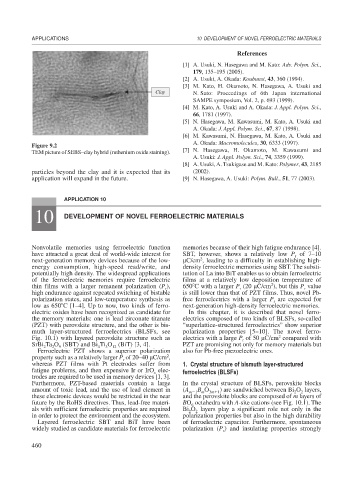Page 488 - Book Hosokawa Nanoparticle Technology Handbook
P. 488
APPLICATIONS 10 DEVELOPMENT OF NOVEL FERROELECTRIC MATERIALS
References
[1] A. Usuki, N. Hasegawa and M. Kato: Adv. Polym. Sci.,
179, 135–195 (2005).
[2] A. Usuki, A. Okada: Koubunsi, 43, 360 (1994).
[3] M. Kato, H. Okamoto, N. Hasegawa, A. Usuki and
Clay N. Sato: Proceedings of 6th Japan international
SAMPE symposium, Vol. 2, p. 693 (1999).
[4] M. Kato, A. Usuki and A. Okada: J. Appl. Polym. Sci.,
66, 1781 (1997).
[5] N. Hasegawa, M. Kawasumi, M. Kato, A. Usuki and
A. Okada: J. Appl. Polym. Sci., 67, 87 (1998).
[6] M. Kawasumi, N. Hasegawa, M. Kato, A. Usuki and
A. Okada: Macromolecules, 30, 6333 (1997).
Figure 9.2
TEM picture of SEBS–clay hybrid (ruthenium oxide staining). [7] N. Hasegawa, H. Okamoto, M. Kawasumi and
A. Usuki: J. Appl. Polym. Sci., 74, 3359 (1999).
[8] A. Usuki, A. Tsukigase and M. Kato: Polymer, 43, 2185
particles beyond the clay and it is expected that its (2002).
application will expand in the future. [9] N. Hasegawa, A. Usuki: Polym. Bull., 51, 77 (2003).
APPLICATION 10
10 DEVELOPMENT OF NOVEL FERROELECTRIC MATERIALS
Nonvolatile memories using ferroelectric function memories because of their high fatigue endurance [4].
have attracted a great deal of world-wide interest for SBT, however, shows a relatively low P of 7–10
r
2
next-generation memory devices because of the low- C/cm , leading to a difficulty in establishing high-
energy consumption, high-speed read/write, and density ferroelectric memories using SBT. The substi-
potentially high density. The widespread applications tution of La into BiT enables us to obtain ferroelectric
of the ferroelectric memories require ferroelectric films at a relatively low deposition temperature of
2
thin films with a larger remanent polarization (P ), 650 C with a larger P (20 C/cm ), but this P value
r
r
r
high endurance against repeated switching of bistable is still lower than that of PZT films. Thus, novel Pb-
polarization states, and low-temperature synthesis as free ferroelectrics with a larger P are expected for
r
low as 650 C [1–4]. Up to now, two kinds of ferro- next-generation high-density ferroelectric memories.
electric oxides have been recognized as candidate for In this chapter, it is described that novel ferro-
the memory materials: one is lead zirconate titanate electrics composed of two kinds of BLSFs, so-called
(PZT) with perovskite structure, and the other is bis- “superlattice-structured ferroelectrics” show superior
muth layer-structured ferroelectrics (BLSFs, see polarization properties [5–10]. The novel ferro-
2
Fig. 10.1) with layered perovskite structure such as electrics with a large P of 50 C/cm compared with
r
SrBi Ta O (SBT) and Bi Ti O (BiT) [3, 4]. PZT are promising not only for memory materials but
9
4
2
2
3
12
Ferroelectric PZT shows a superior polarization also for Pb-free piezoelectric ones.
2
property such as a relatively larger P of 20–40 C/cm ,
r
whereas PZT films with Pt electrodes suffer from 1. Crystal structure of bismuth layer-structured
fatigue problems, and then expensive Ir or IrO elec- ferroelectrics (BLSFs)
x
trodes are required to be used in memory devices [1, 3].
Furthermore, PZT-based materials contain a large In the crystal structure of BLSFs, perovskite blocks
B O
amount of toxic lead, and the use of lead element in (A m 1 m 3m 1 ) are sandwiched between Bi O layers,
2
2
these electronic devices would be restricted in the near and the perovskite blocks are composed of m layers of
future by the RoHS directives. Thus, lead-free materi- BO octahedra with A-site cations (see Fig. 10.1). The
6
als with sufficient ferroelectric properties are required Bi O layers play a significant role not only in the
2
2
in order to protect the environment and the ecosystem. polarization properties but also in the high durability
Layered ferroelectric SBT and BiT have been of ferroelectric capacitor. Furthermore, spontaneous
widely studied as candidate materials for ferroelectric polarization (P ) and insulating properties strongly
s
460

